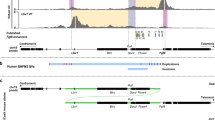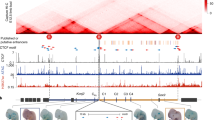Abstract
Early outgrowth of the vertebrate embryonic limb requires signalling by the apical ectodermal ridge (AER) to the progress zone (PZ), which in response proliferates and lays down the pattern of the presumptive limb in a proximal to distal progression1. Signals from the PZ maintain the AER until the anlagen for the distal phalanges have been formed2. The semidominant mouse mutant dactylaplasia (Dac) disrupts the maintenance of the AER, leading to truncation of distal structures of the developing footplate, or autopod3,4,5. Adult Dac homozygotes thus lack hands and feet except for malformed single digits, whereas heterozygotes lack phalanges of the three middle digits. Dac resembles the human autosomal dominant split hand/foot malformation (SHFM) diseases. One of these, SHFM3, maps to chromosome 10q24 (Refs 6,7), which is syntenic to the Dac region on chromosome 19, and may disrupt the orthologue of Dac. We report here the positional cloning of Dac and show that it belongs to the F-box/WD40 gene family, which encodes adapters that target specific proteins for destruction by presenting them to the ubiquitination machinery8. In conjuction with recent biochemical studies9,10,11,12, this report demonstrates the importance of this gene family in vertebrate embryonic development.
This is a preview of subscription content, access via your institution
Access options
Subscribe to this journal
Receive 12 print issues and online access
$209.00 per year
only $17.42 per issue
Buy this article
- Purchase on Springer Link
- Instant access to full article PDF
Prices may be subject to local taxes which are calculated during checkout




Similar content being viewed by others
Accession codes
References
Saunders, J.W. The proximo-distal sequence of origin of the parts of the chick wing and the role of the ectoderm. J. Exp. Zool. 108, 363–403 (1948).
Saunders, J.W. & Gasseling, M.T. Trans-filter propagation of apical ectoderm maintenance factor in the chick embryo wing bud. Dev. Biol. 7, 64–78 ( 1963).
Chai, C.K. Dactylaplasia in mice. J. Hered. 72, 234–237 (1981).
Johnson, K.R., Lane, P.W., Ward-Bailey, P. & Davisson M.T. Mapping the mouse Dactylaplasia mutation, Dac, and a gene that controls its expression, mdac. Genomics 29, 457–464 (1995).
Crackower, M.A., Motoyama, J. & Tsui, L.C. Defect in the maintenance of the apical ectodermal ridge in the Dactylaplasia mouse. Dev. Biol. 201, 78–89 (1998).
Nunes, M.E. et al. A second autosomal split hand/split foot locus maps to chromosome 10q24-q25. Hum. Mol. Genet. 4, 2165– 2170 (1995).
McKusick, V.A. Mendelian Inheritance in Man. Catalogs of Human Genes and Genetic Disorders (Johns Hopkins University Press, Baltimore, 1998).
Patton, E.E., Willems, A.R. & Tyers, M. Combinatorial control in ubiquitin-dependent proteolysis: don't Skp the F-box hypothesis. Trends Genet. 14, 236–43 (1998).
Latres, E., Chiaur, D.S. & Pagano, M. The human F box protein β-TrCP associates with the Cul1/Skp1 complex and regulates the stability of β-catenin. Oncogene 18, 849–854 ( 1999).
Spencer, E., Jiang, J. & Chen, Z.J. Signal-induced ubiquitination of IκBα by the F-box protein Slimb/β-TrCP. Genes Dev. 13, 284–294 (1999).
Winston, J.T. et al. The SCFβ-TRCP-ubiquitin ligase complex associates specifically with phosphorylated destruction motifs in IκBα and β-catenin and stimulates IκBα ubiquitination in vitro. Genes Dev. 13, 270–283 ( 1999).
Yaron, A. et al. Identification of the receptor component of the IκBα-ubiquitin ligase. Nature 396, 590– 594 (1998).
Keller, S.A. et al. Kidney and retinal defects (Krd), a transgene-induced mutation with a deletion of mouse chromosome 19 that includes the Pax2 locus. Genomics 23, 309–320 ( 1994).
Kazazian, H.H. Jr Mobile elements and disease. Curr. Opin. Genet. Dev. 8, 343–350 ( 1998).
Ji, W., Zhang, X.Y., Warshamana, G.S., Qu, G.Z. & Ehrlich, M. Effect of internal direct and inverted Alu repeat sequences on PCR. PCR Methods Appl. 4, 109–116 (1994).
Bai, C. et al. SKP1 connects cell cycle regulators to the ubiquitin proteolysis machinery through a novel motif, the F-box. Cell 86 , 263–274 (1996).
Kominami, K., Ochotorena, I. & Toda, T. Two F-box/WD-repeat proteins Pop1 and Pop2 form hetero- and homo-complexes together with cullin-1 in the fission yeast SCF (Skp1-Cullin-1-F-box) ubiquitin ligase. Genes Cells 3, 721– 735 (1998).
Skowyra, D., Craig, K.L., Tyers, M., Elledge S.J. & Harper, J.W. F-box proteins are receptors that recruit phosphorylated substrates to the SCF ubiquitin-ligase complex. Cell 91, 209–219 (1997).
Wolf, D.A., McKeon, F. & Jackson, P.K. F-box/WD repeat proteins Pop1p and Pop2p form heterooligomeric complexes to bind and direct the proteolytic destruction of Cdc18p. Curr. Biol. (in press).
Yam, C.H., Ng, R.W., Siu, W.Y., Lau, A.W. & Poon, R.Y. Regulation of cyclin A-Cdk2 by SCF component Skp1 and F-box protein Skp2. Mol. Cell. Biol. 19, 635–645 (1999).
Jiang, J. & Struhl, G. Regulation of the Hedgehog and Wingless signalling pathways by the F-box/WD40-repeat protein Slimb. Nature 391, 493–496 ( 1998).
Wall, M.A. et al. The structure of the G protein heterotrimer Gi α 1 β 1 γ 2. Cell 83, 1047– 1058 (1995).
Altabef, M., Clarke, J.D. & Tickle, C. Dorso-ventral ectodermal compartments and origin of apical ectodermal ridge in developing chick limb. Development 124, 4547–4556 (1997).
Loomis, C.A., Kimmel, R.A., Tong, C.X., Michaud, J. & Joyner, A.L. Analysis of the genetic pathway leading to formation of ectopic apical ectodermal ridges in mouse Engrailed-1 mutant limbs. Development 125, 1137–1148 (1998).
Michaud, J.L., Lapointe, F. & Le Douarin, N.M. The dorsoventral polarity of the presumptive limb is determined by signals produced by the somites and by the lateral somatopleure. Development 124, 1453– 1463 (1997).
Dolle, P., Izpisua-Belmonte, J.C., Boncinelli, E. & Duboule, D. The Hox-4.8 gene is localized at the 5′ extremity of the Hox-4 complex and is expressed in the most posterior parts of the body during development. Mech. Dev. 36, 3–13 (1991).
Lyons, K.M., Pelton, R.W. & Hogan, B.L. Organogenesis and pattern formation in the mouse: RNA distribution patterns suggest a role for bone morphogenetic protein-2A (BMP-2A). Development 109, 833– 844 (1990).
Wilkinson, D.G. & Nieto, M.A. Detection of messenger RNA by in situ hybridization to tissue sections and whole mounts. Methods Enzymol. 225, 361–373 (1993).
Sidow, A. et al. Serrate2 is disrupted in the mouse limb-development mutant syndactylism. Nature 389, 722– 725 (1997).
Altschul, S.F. et al. Gapped BLAST and PSI-BLAST: a new generation of protein database search programs. Nucleic Acids Res. 25, 3389–3402 (1997).
Acknowledgements
We thank J. Dausman and R. Curry for help with mice; Z. Husain, K. Harris, K. Devon, K. Dewar, J. Rioux, T. Green, A. Kirby and C. Nusbaum for help with YACs, BACs and sequencing; K. Kusumi, M. Hosobuchi, J. Segre, B. Hamilton, D. Fambrough, A. Bortvin and members of the Jaenisch laboratory for discussions; and H. Sweet and P. Lane for expert assistance in initial characterization and linkage crosses of Dac1J and Dac2J mice.
Author information
Authors and Affiliations
Corresponding authors
Rights and permissions
About this article
Cite this article
Sidow, A., Bulotsky, M., Kerrebrock, A. et al. A novel member of the F-box/WD40 gene family, encoding dactylin, is disrupted in the mouse dactylaplasia mutant. Nat Genet 23, 104–107 (1999). https://doi.org/10.1038/12709
Received:
Accepted:
Issue Date:
DOI: https://doi.org/10.1038/12709
This article is cited by
-
Dissection of the Fgf8 regulatory landscape by in vivo CRISPR-editing reveals extensive intra- and inter-enhancer redundancy
Nature Communications (2021)
-
Duplication of 10q24 locus: broadening the clinical and radiological spectrum
European Journal of Human Genetics (2019)
-
Split-hand/foot malformation - molecular cause and implications in genetic counseling
Journal of Applied Genetics (2014)
-
Discontinuous microduplications at chromosome 10q24.31 identified in a Chinese family with split hand and foot malformation
BMC Medical Genetics (2013)
-
17p13.3 microduplications are associated with split-hand/foot malformation and long-bone deficiency (SHFLD)
European Journal of Human Genetics (2011)



